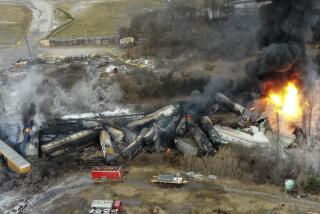Moved Signal May Be Key in Train Crash, Probers Say
- Share via
WASHINGTON — The fiery collision that killed 11 people on a Maryland commuter train in Silver Spring, Md., Friday might have been avoided if a key warning signal had not been removed three years ago, federal investigators said Sunday night.
The signal that should have warned the Maryland commuter train engineer to slow down as he approached an oncoming Amtrak train was relocated as part of a $13-million overhaul of signals along the Maryland Rail Commuter Service line, officials said.
Federal investigators said they also are probing possible problems with escape routes from the burning MARC car where the eight passengers died. Several people were seen pounding on the train’s windows as flames shot from the car.
As part of the 1993 signal overhaul, the yellow warning light between the Kensington and Silver Spring train stations was removed, which shifted the warning function to the signal west of Kensington.
The change meant the MARC train engineer had more distance--and a full stop at the Kensington station--after passing the signal to slow down on approach to a red light in Silver Spring. As he pulled out of the Kensington station, the MARC engineer accelerated to 63 mph. In an interview, National Transportation Safety Board member John Goglia said the signal removal was unwise and suggested that CSX Corp., the Richmond, Va.-based owner of that railroad stretch, be asked why it made the change.
Investigators also are probing possible problems with jammed escape routes on the flaming commuter train. Goglia said the windows failed to pop out during the emergency, and another investigator said they were unmarked.
The MARC engineer, two conductors and eight young people returning from a Job Corps program in West Virginia were killed when the commuter train, running at 40 mph with its emergency brakes applied, smashed head-on into the lead engine of an Amtrak train moving at 30 mph.
Another day’s investigation continued to point the probe toward human error. A key test on the signal system Sunday showed that the caution signal before Kensington operated properly when the signal at the accident location showed red. Goglia said further tests are necessary.
More to Read
Sign up for Essential California
The most important California stories and recommendations in your inbox every morning.
You may occasionally receive promotional content from the Los Angeles Times.












